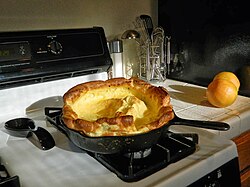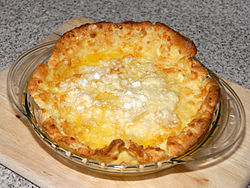Dutch baby pancake
 Dutch baby pancake fresh out of the oven | |
| Alternative names | German pancake, Bismarck, Dutch puff |
|---|---|
| Type | Popover |
| Place of origin | United States |
| Region or state | Washington |
| Main ingredients | Eggs, wheat flour, milk, vanilla, cinnamon |

A Dutch baby pancake, sometimes called a German pancake,[1] a Bismarck, a Dutch puff, Hooligan, or a Hootenanny,[2][3] is a dish that is similar to a large Yorkshire pudding.[4]
Unlike most pancakes, Dutch babies are baked in the oven, rather than being fried. They are generally thicker than most pancakes and contain no chemical leavening ingredients such as baking powder.
They can be sweet or savory[5] and can be served at any meal.[6][7]
The idea of a Dutch baby pancake may have been derived from the German Pfannkuchen, but the current form originated in the US in the early 1900s.[8][9][10][11]
Ingredients and preparation
[edit]It is made with eggs, flour, sugar and milk, and usually seasoned with vanilla and cinnamon, although occasionally fruit or another flavoring is also added. A basic batter incorporates a third of a cup of flour and a third of a cup of milk per egg.
It is baked in a hot cast iron or metal pan and falls (deflates) soon after being removed from the oven. It is generally served with fresh squeezed lemon, butter, and powdered sugar, fruit toppings or syrup.
Serving
[edit]It can be served for breakfast, brunch, lunch, dessert, and even for "brinner" (breakfast for dinner).[12][13] Dutch baby pancakes are generally served immediately upon removal from the oven.
The Dutch baby is a specialty of some diners and chains that specialize in breakfast dishes, such as the Oregon-founded The Original Pancake House or the New England–based chain Bickford's, which makes both a plain Dutch baby and a similar pancake known as the Baby Apple, which contains apple slices embedded in the pancake.
History
[edit]According to Sunset magazine,[14] Dutch babies were introduced in the first half of the 1900s at Manca's Cafe, a family-run restaurant that was located in Seattle, Washington, and that was owned by Victor Manca.[15] While these pancakes are derived from the German pancake dish, it is said that the name Dutch baby was coined by one of Victor Manca's daughters, where "Dutch" perhaps was her corruption of the German autonym deutsch. Manca's Cafe claimed that it owned the trademark for Dutch babies in 1942.[15][16]
Similar dishes
[edit]A Dutch baby is a type of popover, although popovers are generally baked as smaller, individual pieces, approximately the size of a muffin.
A Dutch baby is very similar to a Yorkshire pudding, with a few differences: the Yorkshire pudding is more likely to be baked in individual servings, the pan is usually greased with beef drippings, and the result is rarely sweet.[4] Dutch babies are larger, use butter rather than beef fat, and are frequently sweet. They use more eggs than a Yorkshire pudding and normally have sugar and vanilla and, unlike a Yorkshire pudding, are normally cooked in a cast-iron frying pan.[17]
David Eyre's pancake
[edit] | |
| Type | Pancake |
|---|---|
| Main ingredients | Eggs, milk, flour, nutmeg |
A "David Eyre's pancake" is a variation on the Dutch baby pancake named after the American writer and editor David W. Eyre (1912–2008). The recipe was published by The New York Times Food Editor Craig Claiborne in an April 10, 1966, Times article entitled "Pancake Nonpareil"; in addition to generally regularizing quantities and temperatures for modern use, it omitted sugar and salt from the batter.[18] In the article, Claiborne recounted discovering the dish at a breakfast prepared by Eyre, then the editor of Honolulu magazine, while Claiborne was visiting Eyre's Honolulu home.[19]
Eyre's version of the pancake was based on a recipe for Dutch baby pancakes from Victor Hirtzler's Hotel St. Francis Cookbook[20][21][22][23][24]—the best-known 1919 edition[25]—with slight alteration.
The recipe also appears in The Essential New York Times Cookbook, whose author, longtime food writer Amanda Hesser, counts it among her favorites. She names it as one of the top five recipes recommended to her for inclusion when she set out to write the book.[26]
See also
[edit]- Æbleskiver (Danish Pancake)
- List of pancakes
- Poffertjes
- Flaugnarde, French style apples in batter
- Clafoutis, French style cherries in batter
- Far Breton, a thick Breton cake
 food portal
food portal
References
[edit]- ^ Hirtzler, Victor (1919). The Hotel St. Francis Cook Book. p. 381. Archived from the original on 12 February 2016. Retrieved 29 January 2014.
- ^ "Hootenannies (otherwise known as German Pancakes) |". Real Mom Kitchen. 5 August 2008. Retrieved 26 November 2020.
- ^ "German Pancakes or Simple Hootenanny". Made It. Ate It. Loved It. 1 May 2018. Retrieved 26 November 2020.
- ^ a b Campbell-Schmitt, Adam (15 May 2018). "Dutch Baby or Yorkshire Pudding? Brits Argue Their Savory Dish Should Never Go Sweet". Food & Wine. Retrieved 27 September 2018.
- ^ "Herby Dutch Baby With Smoked Salmon". Bon Appétit. 15 March 2022. Retrieved 20 April 2022.
- ^ Laperruque, Emma (23 October 2021). "A pancake for when I'm too lazy to make pancakes". Salon. Retrieved 20 April 2022.
- ^ Brehaut, Laura (4 December 2020). "Cook this: Cheesy Dutch baby from Dinner Uncomplicated". National Post. Retrieved 20 April 2022.
- ^ OBrien, Sam. "This Giant Pancake Is Breakfast and Dessert". Atlas Obscura. Retrieved 27 September 2018.
- ^ Peterson, Lucas (10 November 2016). "Seattle's Dutch Babies Are the Sweet, Savory Breakfast Food You Deserve". Eater. Retrieved 27 September 2018.
- ^ Flood, Chuck (2017). Lost Restaurants of Seattle. Arcadia Publishing. p. 38. ISBN 978-1-4671-3704-1. Retrieved 4 April 2020.
- ^ Maas, Sebastian (15 February 2023). "Kochen ohne Kohle: Der »deutsche Pfannkuchen«, den in Deutschland niemand kennt". Der Spiegel (in German). ISSN 2195-1349. Retrieved 1 March 2023.
- ^ Meyer, Ashley. "What on earth is a Dutch Baby?". Retrieved 20 April 2022.
- ^ Fabricant, Florence. "Dutch Baby Recipe". The New York Times. Retrieved 19 May 2018.
- ^ "Dutch baby pancakes," Sunset (magazine), February 1960.
- ^ a b "history of Manca's Cafe – manca's cafe". www.mancascafe.com. Archived from the original on 11 January 2012. Retrieved 22 July 2012.
- ^ Albala, Ken (2013). Pancake: A Global History. Reaktion Books. p. 10. ISBN 978-1-78023-237-9.
- ^ Morrissy-Swan, Tomé (14 May 2018). "Have Americans re-invented the Yorkshire pudding as the 'Dutch Baby'?". The Telegraph. Retrieved 19 May 2018.
- ^ "1966: David Eyre's Pancake". The New York Times. 26 March 2007. Retrieved 4 December 2010.
- ^ "David Eyre, Hawaii author, Honolulu magazine co-editor". Honolulu Advertiser. 2 February 2008. Retrieved 4 December 2010.
- ^ The Hotel St. Francis Cook Book by Victor Hirtzler – Free Ebook – gutenberg.org, p. 382
- ^ Hirtzler, Victor (9 September 2018). "The Hotel St. Francis cook book". Chicago Ill. : The Hotel Monthly Press – via Internet Archive.
- ^ Hirtzler, Victor; Monnette, Helen K. ins (9 September 2018). "The Hotel St. Francis cook book;". Chicago, Ill., The Hotel monthly press – via Internet Archive.
- ^ Hirtzler, Victor; Hotel St. Francis (San Francisco, Calif ). "The Hotel St. Francis cook book;". Chicago Ill. : The Hotel Monthly Press – via Internet Archive.
- ^ Victor Hirtzler (9 September 2018). "The Hotel St. Francis Cook Book". The Hotel Monthly Press – via Internet Archive.
- ^ "David Eyre's Pancake: 1966". Food52. 29 October 2010. Retrieved 4 December 2010.
- ^ First, Devra (17 November 2010). "A cookbook of the lost and found". Boston.com. Retrieved 4 December 2010.
